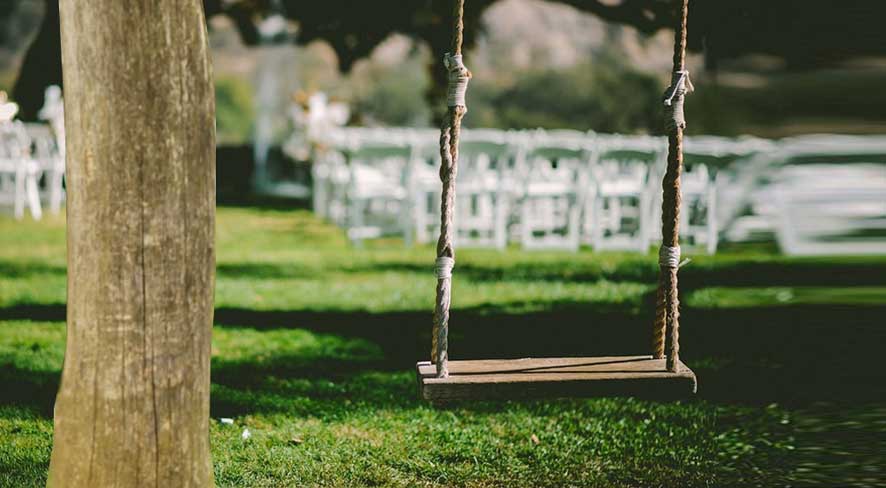Children love swings! But then again, who doesn’t, right? Kids or adults, everyone likes the idea of spending the late afternoon hours in the backyard, swinging away, catching the breeze in their hair! However, the most significant problem people have when installing an outdoor baby swing is that they don’t have a tree with sturdy branches. If you’re going through the same issue, worry not! Here’s how you can install a tree swing no horizontal branch needed!
Best 2 Ways to Hang a Swing without Horizontal Tree Branches
Essentially, there are two ways to install a tree swing without the availability of branches. One of the methods requires a single tree, while the other requires two. Depending on your convenience and availability of trees in your backyard, you can choose either one.
1. Hang a Swing Using One Tree (tree swing no horizontal branch)
Suppose that you only have one tree available, and that too doesn’t have the healthy, large branches you need to install a swing. In another case, you might have several trees, but none of them are aligned together to give you the ideal spacing. In either scenario, here’s what you can do:
Picking a Tree –
Select the sturdiest tree that you can find. Even if it doesn’t have the branches, it needs to be strong and resilient enough to carry your child’s weight. If you want help with the selection, pick a relatively older tree since older ones can sustain more weight. Their roots are fully developed and fixed, and their bodies are sturdy.
A younger tree might look healthy, but there’s no way to make sure it’s fully developed yet. Thus, “play” on the safer side and pick the older one. Decade-old oak trees are the preferable choices.
Recommend to read:
This video may help more as visualize the idea :
Making an Artificial Branch –
Here’s the magic part! If your tree doesn’t have a horizontal branch, you can make one! Pick a suitable material for this purpose; make sure it is strong and resistant. Popular and preferable options include metal boards or strong wooden boards.
Apart from the strength and resistance of the material, make sure it is adaptable as well. Since you are going to nail or drill it into the tree, it should take the necessary shape and adapt to the position.
Last but not least, pay special attention to the length of the board as well. The branch should be a minimum of 1.5 meters in length. The thickness, however, depends on the weight you are going to put on it.
Attaching an Artificial Branch –
Once the artificial branch is complete and you’re entirely satisfied with the way it looks and feels, it’s time to attach it to the tree. This part is relatively more comfortable and doesn’t take more than a few minutes. Take a drill, some bolts or nails, and take a good look at the chosen tree.
Observe and find the right spot to attach the branch. This particular spot should be somewhere low, where other branches separate from the tree’s trunk. Place your DIY branch on the trunk and nail it down, making sure it’s fixed in place.
Once this part is complete, notice how much of the branch is hanging outside. This length shouldn’t be more than one or two meters, and the unit should be perfectly parallel to the ground. If your artificial limb ends up being too long, it could compromise the stability and lead to possible hazards later.

Hanging the Swing –
You are almost there! If you have a swing already, good! If not, you can purchase an entire kit that features ropes, chains, hooks, and a swing board. You can even make your swing at home if you want. There are several different types of DIYs on the internet, and you’ll have loads of fun doing this activity with your child. Plus, you’ll be saving quite a lot of bucks!
Once you get your hands on the swing, hang it from the artificial branch, and test it out! Let your child sit on the swing for a few minutes while you supervise. Check the branch and make sure it’s not moving. Ensure that it’s stable, and the swing isn’t making any uncomfortable movements.
2. Hang a Swing Using Two Trees (tree swing no horizontal branch)
If you’re lucky enough to find two consecutive trees aligned correctly, it’s an opportunity- take it! The process is pretty much the same: making sure that the trees are sturdy and robust, creating a fake branch, and attaching it to the trees. However, there are a few additional steps and benefits to this method.
Once you have the board ready, attach it to both the trees. It’s way more stable than installing a swing on one tree and ensures more safety. Nail the board on both the tree trunks, but make sure the distance is no more than 5 meters. Excessively long lengths and distances can compromise the safety and stability you were going for in the first place. Now, attach the swing as you did in the first method and test it out under supervision for a few minutes.
Some Extra Steps to Ensure Better Safety –
[su_list icon=”icon: hand-o-right” icon_color=”#567ac3″]
-
- Don’t let your child sit on a swing unsupervised if they are younger than four years.
-
- Make sure the rope is high-quality and doesn’t have any flaws or weak spots. Also, change the rope every couple of years.
-
- Double-check the knots, nails, and joints, if any, and make sure everything is secure.
-
- Before finishing and finalizing, have your kid try it out. This way, you can make sure the height is appropriate for your child. Swings that are too high or too low can be unstable and uncomfortable.
[/su_list]
In Conclusion –
So that’s how you install a tree swing; no horizontal branch needed! Pretty simple and easy, no? Hence, if you don’t think you have the ideal space for a swing in your backyard, look again. But this time, look with a keen eye and see how creative you can be with a little bit of motivation and an artificial branch!


